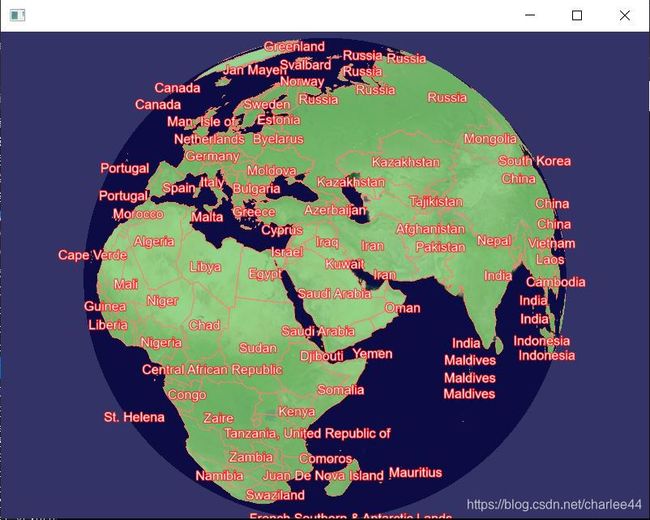osgEarth使用笔记4——加载矢量数据
文章目录
- 1. 概述
- 2. 详论
-
- 2.1. 基本绘制
- 2.2. 矢量符号化
-
- 2.2.1. 可见性
- 2.2.2. 高度设置
- 2.2.3. 符号化
- 2.2.4. 显示标注
- 2.3. 其他
- 3. 结果
- 4. 问题
1. 概述
前面文章加载的底图数据是一种栅格数据,还有一种很重要的地理信息表现形式是矢量数据。在osgEarth中,这部分包含的内容还是很丰富的,这里就总结一二。
2. 详论
2.1. 基本绘制
在《osgEarth使用笔记1——显示一个数字地球》这篇文章中代码的基础之上,添加加载显示矢量的代码:
#include osgEarth表达矢量的基本思路是,先将其读取到矢量源图层FeatureSourceLayer中,这个图层加载到osgEarth的图层列表中是不显示的,必须得再加载一个专门的符号化图层,将其符号号,才能正常显示。这里使用的是FeatureModelLayer,也就是将这个矢量当成模型来加载。运行这段程序显示结果如下:

这个矢量加载的是osgEarth自带的矢量地图world.shp,是一个面矢量,但是显示的效果却不太正确,也是因为没有设置合适的符号化方式。
2.2. 矢量符号化
矢量符号化在osgEarth中被抽象成了类似于CSS中样式表StyleSheet,可以在其中加载样式Style:
//设置样式
osgEarth::Symbology::Style style;
//具体设置
//...
//
osgEarth::Features::FeatureModelLayerOptions fmlOpt;
fmlOpt.name() = filePath;
fmlOpt.featureSourceLayer() = filePath + "_source";
fmlOpt.enableLighting() = false;
fmlOpt.styles() = new osgEarth::Symbology::StyleSheet();
fmlOpt.styles()->addStyle(style);
osg::ref_ptr<osgEarth::Features::FeatureModelLayer> fml = new osgEarth::Features::FeatureModelLayer(fmlOpt);
map->addLayer(fml);
2.2.1. 可见性
设置是否启用深度测试:
//可见性
osgEarth::Symbology::RenderSymbol* rs = style.getOrCreate<osgEarth::Symbology::RenderSymbol>();
rs->depthTest() = false;
2.2.2. 高度设置
//贴地设置
osgEarth::Symbology::AltitudeSymbol* alt = style.getOrCreate<osgEarth::Symbology::AltitudeSymbol>();
alt->clamping() = alt->CLAMP_TO_TERRAIN;
alt->technique() = alt->TECHNIQUE_DRAPE;
osgEarth有三种设置高度的方式,分别是:贴地,相对高程和绝对高程。我这里是将其设置为贴地。

矢量贴地有多种技术实现方式,对每一种情况来说,并不存在一种最好的方式,需要根据实际的情况去设置,具体的技术说明可以参考osgEarth文档:

2.2.3. 符号化
接下来就是设置具体的样式了。这个矢量是个面矢量,所以给它设置一个面的样式,包含边界线和填充效果:
//设置矢量面样式(包括边界线)
osgEarth::Symbology::LineSymbol* ls = style.getOrCreateSymbol<osgEarth::Symbology::LineSymbol>();
ls->stroke()->color() = osgEarth::Symbology::Color("#FA8072");
ls->stroke()->width() = 1.0;
ls->tessellationSize()->set(100, osgEarth::Units::KILOMETERS);
osgEarth::Symbology::PolygonSymbol *polygonSymbol = style.getOrCreateSymbol<osgEarth::Symbology::PolygonSymbol>();
polygonSymbol->fill()->color() = osgEarth::Symbology::Color(152.0f / 255, 251.0f / 255, 152.0f / 255, 0.8f); //238 230 133
polygonSymbol->outline() = true;
2.2.4. 显示标注
可以将矢量中存储的字段作为注记,标注在地图中。这时可以另外新建一个FeatureModelLayer图层,并且还是会用到之间已经读取好的FeatureSourceLayer,只不过显示的样式修改为文字样式TextSymbol:
void AddAnno(std::string filePath, osg::ref_ptr<osgEarth::Map> map)
{
osgEarth::Symbology::Style labelStyle;
osgEarth::Symbology::TextSymbol* text = labelStyle.getOrCreateSymbol<osgEarth::Symbology::TextSymbol>();
string name = "[CNTRY_NAME]"; //如果需要显示汉字,则需要转换成UTF-8编码
text->content() = osgEarth::Symbology::StringExpression(name);
text->priority() = osgEarth::NumericExpression( "[pop_cntry]" );
text->size() = 16.0f;
text->alignment() = osgEarth::Symbology::TextSymbol::ALIGN_CENTER_CENTER;
text->fill()->color() = osgEarth::Symbology::Color::White;
text->halo()->color() = osgEarth::Symbology::Color::Red;
text->encoding() = osgEarth::Symbology::TextSymbol::ENCODING_UTF8;
//string fontFile = PathRef::GetAppDir() + "/fonts/SourceHanSansCN-Regular.ttf";
//text->font() = fontFile; //如果显示汉字,需要支持中文字库的字体
// and configure a model layer:
osgEarth::Features::FeatureModelLayerOptions fmlOpt;
fmlOpt.name() = filePath + "_labels";
fmlOpt.featureSourceLayer() = filePath + "_source";
fmlOpt.styles() = new osgEarth::Symbology::StyleSheet();
fmlOpt.styles()->addStyle(labelStyle);
osg::ref_ptr<osgEarth::Features::FeatureModelLayer> fml = new osgEarth::Features::FeatureModelLayer(fmlOpt);
map->addLayer(fml);
}
注意osgEarth中显示汉字还是很麻烦的,最好矢量和代码相关的设置都是UTF-8编码的。
2.3. 其他
在最后的结果中如果线要素或者其他特征要素还是无法渲染,那么可能就是需要初始化状态设置:
//解决Lines or Annotations (FeatureNode, etc.) 不被渲染的问题
osgEarth::GLUtils::setGlobalDefaults(viewer.getCamera()->getOrCreateStateSet());
3. 结果
整理的完整代码如下:
#include 4. 问题
osgEarth中矢量符号化的样式机制非常强大,甚至可以将面按照线绘制,线按照点来绘制。但是这样就会造成一个问题,那就是矢量类型如果判断不正确,渲染的效果就不正确,除非事先知道是点、线或者面。可以从矢量图层中获取到FeatureSource这个类,存在的getGeometryType()接口获取的类型有时候不太正确(有时候返回成osgEarth::Symbology::Geometry::TYPE_UNKNOWN)。
一直困扰的两个问题就来了:
- 对于DXF这种可能包含点、线、面三种类型的矢量加载之后,如何设置样式,保证点按照点样式渲染,线按照线样式渲染,面按照面样式渲染呢?
- 如何修改矢量中某个或者某些特定要素的样式?最好是不重新加载数据。
这两个问题估计只能留待以后解决了。

